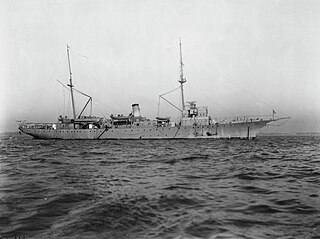
USS Sumner (AG-32/AGS-5) was a survey ship in the United States Navy. She was named in honor of Thomas Sumner. She was originally commissioned as a submarine tender as USS Bushnell (AS-2/AG-32), in honor of David Bushnell, the inventor of the first American submarine.

USS Turkey (AM-13) was a Lapwing-class minesweeper the U.S. Navy, thus named after the bird, not after the country which in 1917 was an enemy in the ongoing World War I. The minesweeper was acquired by for the dangerous task of removing mines from minefields laid in the water to prevent ships from passing.

USS Wesson (DE-184) was a Cannon-class destroyer escort built for the United States Navy during World War II. She served in the Pacific Ocean and provided escort service against submarine and air attack for Navy vessels and convoys. She returned home at war's end with a very respectable seven battle stars to her credit.

USS Chickasaw (AT-83/ATF-83) was a Navajo-class fleet tug constructed for the United States Navy during World War II. She served in the Pacific Ocean in World War II and the Korean War, and was awarded six battle stars for World War II and two battle stars during the Korean War.

USS Edmonds (DE-406) was a John C. Butler-class destroyer escort in service with the United States Navy from 1944 to 1946 and from 1951 to 1965. She was scrapped in 1973.
USS LST-888 was an LST-542-class tank landing ship built for the United States Navy during World War II. Late in her career she was renamed Lee County (LST-888) – after counties in twelve Southern and Midwestern states, the only U.S. Naval vessel to bear that name – but saw no active service under that name.

USS Snowbell (YN-71/AN-52) was a Ailanthus-class net laying ship which served the U.S. Navy during World War II. She operated in the Pacific Ocean until she was destroyed by Typhoon Louise off Okinawa, 9 October 1945.
USS Chinquapin (YN-12/AN-17) was an Aloe-class net laying ship built for the United States Navy during World War II. Originally ordered as USS Fir (YN-2), she was renamed and renumbered to Chinquapin (YN-12) in October 1940 before construction began. She was launched in July 1941, and completed in October 1941. Placed in service at that time without being commissioned, she was commissioned in January 1943, and decommissioned in March 1946. She was placed in reserve at that time and scrapped in 1976.

USS Terebinth (AN-59) – laid down as USS Balm (YN-78) – was a Ailanthus-class net laying ship which served with the U.S. Navy during World War II. Terebinth served in the Pacific Ocean theatre of operations and was awarded a battle star for her participation in the Okinawa campaign. Post-war she was decommissioned and sold.
USS Spicewood (AN-53/YN-72) was an Ailanthus-class net laying ship which served with the U.S. Navy in the South Pacific Ocean theatre of operations during World War II. Her career was without major incident, and she returned home after the war bearing one battle star to her credit.

USS Silverbell (AN-51/YN-70) was an Ailanthus-class net laying ship which served with the U.S. Navy in the South Pacific Ocean theatre of operations during World War II. Her career was without major incident, and she returned home after the war bearing one battle star to her credit.
USS Papaya (AN-49/YN-68) was an Ailanthus-class net laying ship which served with the U.S. Navy in the South Pacific Ocean theatre of operations during World War II. Her career was without major incident, and she returned home after the war bearing two battle stars to her credit.
USS Canotia (AN-47/YN-66) was an Ailanthus-class net laying ship which served with the U.S. Navy in the South Pacific Ocean theatre of operations during World War II. Her career was without major incident, and she returned home after the war bearing one battle star to her credit.
USS Satinleaf (AN-43/YN-62) was an Ailanthus-class net laying ship which served with the U.S. Navy in the western Pacific Ocean theatre of operations during World War II. Her career was without major incident, and she returned home safely after the war with two battle stars to her credit.

USS Cliffrose (AN-42/YN-61) was an Ailanthus-class net laying ship which served with the U.S. Navy in the western Pacific Ocean theatre of operations during World War II. Her career was without major incident, and she returned home safely after the war with two battle stars to her credit.

USS Baretta (AN-41/YN-60) was an Ailanthus-class net laying ship which served with the U.S. Navy in the western Pacific Ocean theatre of operations during World War II. After surviving war action and Pacific Ocean typhoons, and she returned home safely after the war with one battle star to her credit.

USS Stagbush (AN-69/YN-93) was an Ailanthus-class net laying ship which served with the U.S. Navy in the western Pacific Ocean theatre of operations during World War II. Her career was without major incident, and she returned home safely after the war with one battle star to her credit.
USS Anaqua (AN-40/YN-59) was an Ailanthus-class net laying ship which served with the United States Navy in the Western Pacific Theater of Operations during World War II. She served the U.S. Pacific Fleet with her protective anti-submarine nets, and returned home safely after the war.

USS Teak (AN-35/YN-30) was an Aloe-class net laying ship which served with the U.S. Navy in the Pacific Ocean theatre of operations during World War II. She was assigned to serve the U.S. Pacific Fleet with her protective anti-submarine nets and earned two battle stars and other commendations for her bravery.

USS Jicarilla (ATF-104) was Abnaki-class tugboat during the World War II. The ship was later sold to Colombia as ARC Sebastián De Belalcázar (RM-73). Her namesake is a group of the Apache tribe found in the southwestern United States.












